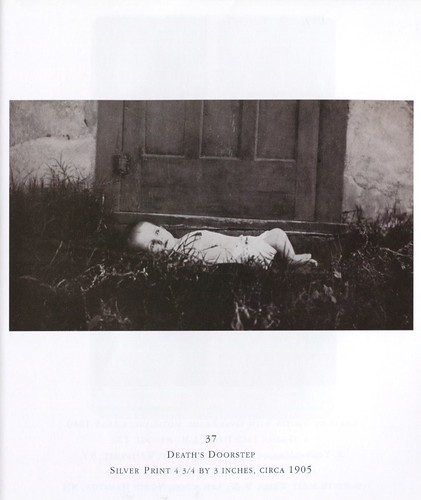This post originally appeared on I Read Odd Books
Book: Sleeping Beauty III, Memorial Photography: The Children
Author: From the Stanley Burns Archive
Type of Book: Non-fiction, photography, death photography, funerary customs
Why Do I Consider This Book Odd: Pictures of dead children will always be a bit odd.
Availability: Released by The Burns Archive in 2011, you can get a copy on Amazon here:
But I would strongly recommend that anyone interested in the macabre photography from the Burns Archive go directly to them. Sometimes you can get the books far cheaper if you buy directly from the press itself. Not always, but compare before you buy. As much as I like the kickbacks I get when y’all buy stuff using my Amazon Affiliate link, sometimes one can get a new Burns Archive book for literally hundreds less on the Burns Archive site than buying it from a third party vendor on other book sites.
Comments: I’d intended to discuss this book long ago but I put it up on display with a piece of art that Mr. Oddbooks bought me. Once something is on a stand behind glass, I am loathe to mess with it too much. However, I recently started using some software to analyze the traffic to this site and noticed a lot of traffic coming from searches about death photography. Then, shockingly, I noticed some hits coming from Pintrest. You know, the site wherein people share pictures of cake, high heels and celebrities with cats. Never thought death photography would be an interest on such a fluffy site, and for some reason, discovering that fact encouraged me to get my book off the stand and discuss it. Actually, I have several Burns Archive books on creepy topics that I should discuss here.
For now, I’m going to discuss Sleeping Beauty III. This book is much smaller in size than Sleeping Beauty I and II, almost appropriately because this volume deals with children exclusively. Sleeping Beauty III has 125 pictures from the 1840s to present time, and spans several cultures. Though the book is definitely Western-centric, and truly most death photography is of white people, this book contains some pictures from other cultures.
A lot of people find memorial photography morbid – if you stumble across a Facebook account where death photography is discussed or reproduced, the comments range from an appreciation of the history to people thinking the parents long ago were insane or that the whole thing in general is somehow morally wrong or gross. “Ewww! Why would anyone want to take a picture of a dead person?” As much as I dislike it when people react to these pictures from a strictly modern sensibility or a squeamish quasi-morality, I often have a hard time explaining why it is such images appeal to me. Burns does his best to explain why these images may seem so jarring:
It is difficult for most of us today to understand the prior culture’s need to take memorial photographs. We no longer live with personal death and dying as part of our everyday lives. By the 1930s, dealing with death had been left to professionals ranging from physicians to morticians. The advance of medicine, control of killer epidemics, the ability to treat disease, and the removal of the sick from the home made us unaccustomed to living with and seeing death. Children dying before parents, something so common in the nineteenth century, has become unusual in the twentieth century.
He goes on:
Memorial postmortem photographs have deep meaning for mourners. These keepsakes become special icons that help survivors move through the bereavement process. Healthy grieving ultimately distances us from the dead. The human bond, our connection with others, is mankind’s strongest guiding emotion and thus influences our fears and actions. These images represent confrontation with our loved one’s mortality and our own.
I would like to think this fear of death that these images can provoke is behind the “Yuck!” reactions people sometimes express.
I often have a hard time discussing death photography because I relate to these images on an emotional level. While the appeal of the Burns Archive collection tends towards the visceral response, Burns offers useful information in the book to give context and history behind the photographs. I find the best way to discuss this little book is to reproduce a few pictures from it and quote the information that Burns provides to help us put these pictures into an historical context.
Reading postmortem photography comes with understanding the culture of death in a given era. Today it is traditional to close the eyes of the dead. But in the past, when a memorial photograph was taken, families frequently requested, especially for children, that the eyes be open. This was particularly the case for children who had never been photographed when they were alive. A second, eyes-closed photograph with changed pose would signal the memorial photograph. Photographs that depict the dead child in some sort of activity as if alive are considered “posthumous mourning portraits.”

This picture is haunting. It looks to me like his eyes may have been painted on the print to make them look open. The symbolism of this little boy at death’s door really isn’t symbolism. He’s dead and gone, and his eyes don’t give this picture any ambiguity.
